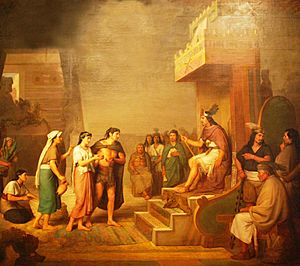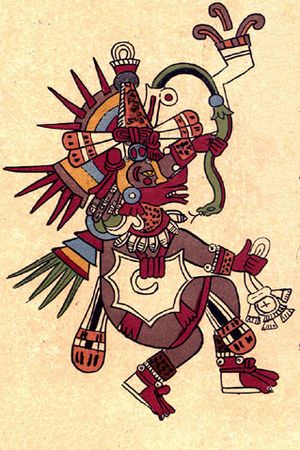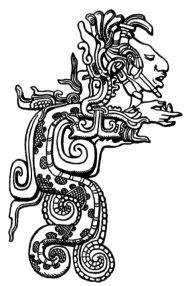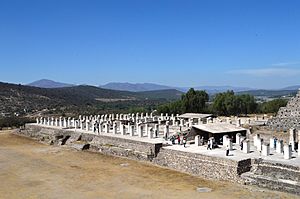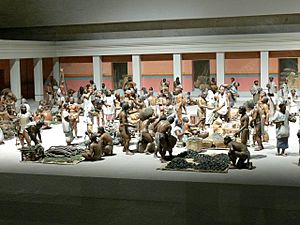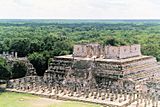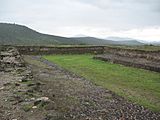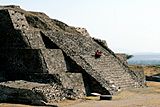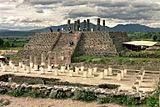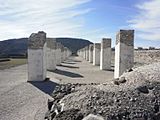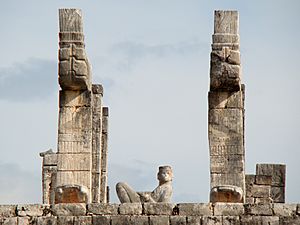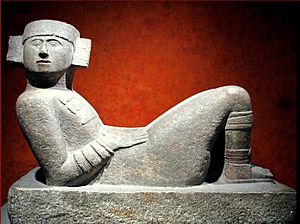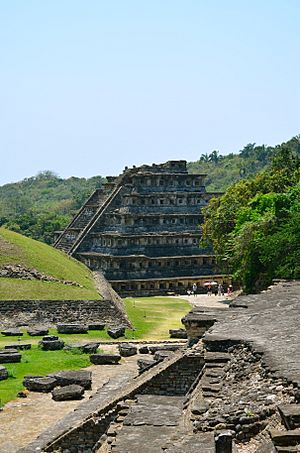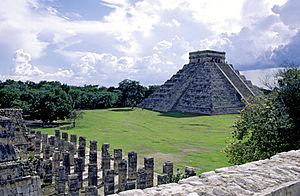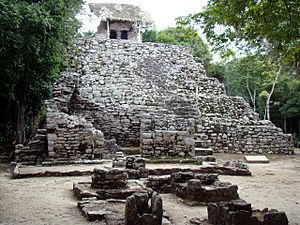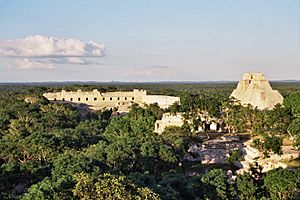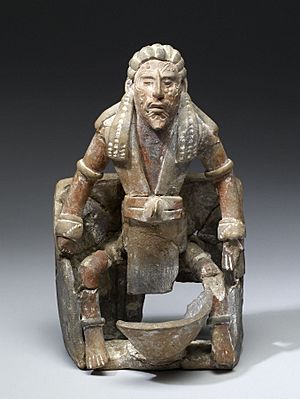Toltec Empire facts for kids
Quick facts for kids
Toltec Empire
Altepetl Tollan
|
|||||||||||||||||||||||||||||
|---|---|---|---|---|---|---|---|---|---|---|---|---|---|---|---|---|---|---|---|---|---|---|---|---|---|---|---|---|---|
| 674 (disputed)–1122 (disputed) | |||||||||||||||||||||||||||||
| Status | disputed | ||||||||||||||||||||||||||||
| Capital | Tollan-Xicocotitlan | ||||||||||||||||||||||||||||
| Common languages | Nahuatl, Itza’, Mixtec, Zapotec, Totonac, Otomi, Pame, Purépecha, others | ||||||||||||||||||||||||||||
| Religion | Toltec religion | ||||||||||||||||||||||||||||
| Government | Monarchy | ||||||||||||||||||||||||||||
| Tlatoani (see List of rulers) | |||||||||||||||||||||||||||||
|
• c. 6th-8th century
|
Chalchiuhtlanetzin or Mixcoamatzatzin (first) | ||||||||||||||||||||||||||||
|
• c. 10th-11th century
|
Topiltzin, Tecpancaltzin or Huemac (last) | ||||||||||||||||||||||||||||
| Historical era | Classic/Post Classic | ||||||||||||||||||||||||||||
|
• Toltecs arrive at Mam-he-mi, and rename it Tollan
|
674 (disputed) | ||||||||||||||||||||||||||||
|
• Topiltzin Ce Acatl Quetzalcoatl goes into exile and leaves for Tlapallan
|
947 (disputed) | ||||||||||||||||||||||||||||
|
• Abandonment of Tollan-Xicocotitlan
|
1122 (disputed) | ||||||||||||||||||||||||||||
|
|||||||||||||||||||||||||||||
|
|||||||||||||||||||||||||||||
The Toltec Empire (also known as the Toltec Kingdom or Altepetl Tollan) was a powerful civilization in what is now Mexico. It was important during the Classic and Post-Classic periods (around 600 to 1200 AD). The Toltecs became very strong in the later Post-Classic period. Their influence spread far, even reaching the Yucatán Peninsula.
The main city of this empire was Tollan-Xicocotitlan. Other important cities included Tulancingo and Huapalcalco.
Contents
The Toltec Empire's Story
Early Toltec Times
Before the Capital City
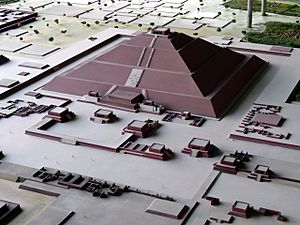
Stories passed down through generations tell us about the Toltecs' beginnings. These stories say there was a city called Tlachicatzin. Its people were known as "Toltecah" because they were very skilled artisans. Around 583 AD, two leaders, Chalcaltzin and Tlacamihtzin, led the Toltecah in a rebellion. After 13 years, they left Tlachicatzin and later founded a new settlement called Tlapallanconco in 604 AD.
Some historians and archaeologists once thought that the Toltec city of Tollan was actually Teotihuacán. However, many experts now disagree with this idea.
Building the Capital and First Rulers
According to old records like the Anales de Cuauhtitlan, the Toltecs arrived in 674 AD. At first, their leaders were priests. Around 700 AD, they changed to a monarchy, where kings (called tlatoani) ruled. The first king was Mimixcoamatzatzin. Some records say they arrived in Tula in 726 AD and started their monarchy in 752 AD.
The history of Toltec kings was written down in many old documents. But these stories sometimes contradict each other. Some lists of rulers begin with Chalchiutlanetzin or Mixcoamatzatzin. Others even include Cē Ācatl Topiltzin Quetzalcoatl.
Historians have studied these lists of Toltec rulers. They found that many of the kings were said to rule for exactly 52 years. This is the length of a special cycle in the Mesoamerican calendars. Because of this, many experts believe that some of these old stories about Toltec kings are more like legends than exact history.
One legend tells of King Tecpancaltzin Iztaccaltzin. A Toltec man named Papantzin created a sweet, fermented drink from the maguey plant, now called pulque. He sent his daughter Xochitl to give it to the king as a gift. The king liked Xochitl and the drink. He eventually married Xochitl, and they had a son named Meconetzin, who became a prince.
Between 900 and 950 AD, the city of Tollan changed a lot. The old city center, Tula Chico, was mostly left behind. A new area, Tula Grande, became the main part of the city. This new area had important religious and political buildings. Tollan also attracted many people from other areas, making it a diverse city. The Nonoalca and Chichimeca Toltecs were the main groups living there.
The Reign of Quetzalcoatl
The Anales de Cuauhtitlan states that the priest-king Cē Ācatl Topiltzin Quetzalcoatl ruled Tollan-Xicocotitlan from 923 to 947 AD. He was born in 895 AD.
Quetzalcoatl was known as a wise and kind ruler. He made Tollan a successful city where people had many good qualities. He was also a very religious man. Cē Ācatl Topiltzin taught against the practice of human sacrifice. He believed that the supreme god, whose name he took, was not pleased with ritual killings.
According to one story, an old man (who was secretly the god Tezcatlipoca) visited King Quetzalcoatl. The old man offered him a drink, which was pulque. After tasting it, the king invited his sister, the priestess Quetzalpetlatl, to drink with him. Because they drank too much, they forgot their sacred duties and damaged their good names. After this, Quetzalcoatl left Tollan in 947 AD. He traveled east to a mythical land called Tlillan-Tlapallan, which was said to be on the coast of the Gulf of Mexico. There, Quetzalcoatl entered a canoe and ended his life.
Conflicts and Moving to Yucatan
Some historians believe Quetzalcoatl died earlier, in 931 AD. This event may have caused political problems in Tollan. It led to many Toltecs moving to other parts of Mesoamerica around 981 AD, especially to the Yucatán Peninsula. They mostly settled in the city of Uxmal.
Regardless of the exact date, old stories say that by the late 900s, a religious war broke out in Tollan. It was between followers of the god Tezcatlipoca and supporters of Quetzalcoatl. Quetzalcoatl's followers did not like large human sacrifices, which he had stopped during his rule. Tezcatlipoca's followers believed sacrifices were a key part of their religion. Also, Quetzalcoatl's supporters were mostly from the Nonoalca group, while Tezcatlipoca's supporters were mostly Chichimeca.
The conflict was short at first, but a second war started later. This war lasted from 1046 to 1110 AD. It ended with the defeat of Quetzalcoatl's followers. Many of them fled Tollan because of the violence. A large number of these exiles went to the Maya region. The cult of Quetzalcoatl (known as Kukulkan in Yucatan) was brought to the region by the Itza around 987 AD. The Itza were a mixed group who welcomed immigrants from Tollan and adopted Toltec religious ideas.
As they traveled south, some of Quetzalcoatl's followers seemed to take on his name, "Quetzalcoatl," or its Maya versions, "Kukulkan" and "Q'uq'umatz." These new "Quetzalcoatl" leaders often led their followers in battles against Maya peoples. These events have sometimes confused researchers, who might mistake these later leaders for Cē Ācatl Topiltzin Quetzalcoatl himself.
The End of the Empire
Tula's Collapse and Toltec Migration
Conflicts between different groups and a big famine (food shortage) from 1070 to 1077 AD caused many Toltecs to leave Tollan. This happened in the late 1000s and early 1100s. One group of Toltec exiles eventually took over the city of Cholula around 1200 AD.
In 1115 AD, tribes from the north attacked the Toltec lands. After fierce battles, the Toltecs were defeated in 1116 AD. After this loss, Huemac, the priest-king of Tollan, left the city with other Toltecs. They went south to the city of Xaltocan. Soon, his closest followers left him and chose a new leader. Most Toltecs then split into smaller groups and spread across Mesoamerica.
By 1122 AD, after Huemac's death, Tula was almost empty. Some Toltecs stayed near the ruins of their old capital. They were then ruled by Culhuacán, a nearby city-state. After Tollan fell in the 1100s, many smaller city-states, called altepetl, took over the former Toltec areas. Many of these new rulers claimed to be descendants of Toltec nobles. Because of this, having Toltec ancestors became a sign of importance. Later empires, like the Aztecs, and kings in Oaxaca and Guatemala, claimed Toltec family lines to make their rule seem more legitimate.
Toltec Rulers
List of Leaders
Old documents describe Toltec rulers, but many of these stories are legends and not fully accurate history. Some lists include figures like Ce Acatl Topiltzin Quetzalcoatl and Queen Xochitl as rulers, but others leave them out.
Here are some lists of Toltec rulers from different historical sources:
| Name | Reign | Lifespan | Family | ||||
|---|---|---|---|---|---|---|---|
| Chalchiuhtlanetzin | 510-562 | ||||||
| Ixtlilcuechahauac | 562-614 | ||||||
| Huetzin | 614-666 | ||||||
| Totepeuh | 666-718 | ||||||
| Nacaxoc | 718-770 | Tlacomihua | 770-826 | ||||
| Xihuiquenitzin | 826-830 | ||||||
| Tecpancaltzin Iztaccaltzin | 830-875 | ?-911 |
|
||||
| Meconetzin | 875-927 | ||||||
| Mitl | 927-979 | ||||||
| Xiuhtlaltzin | 979-983 | ||||||
| Tecpancaltzin | 983–1031 | ||||||
| Topiltzin | 1031–1063 |
According to Francisco Javier Clavijero:
| Name | Reign |
|---|---|
| Chalchiuhtlanetzin | 667-719 |
| Ixtlilcuechahauac | 719-771 |
| Huetzin | 771-823 |
| Totepeuh | 823-875 |
| Nacaxoc | 875-927 |
| Mitl | 927-979 |
| Xiuhtlaltzin | 979-983 |
| Interregnum | 983-1031 |
| Topiltzin | 1031–1063 |
According to the Anales de Cuauhtitlan:
| Name | Reign |
|---|---|
| Mixcoamatzatzin | 701-767 |
| Huetzin | 767-782 |
| Ilhuitimal | 783–821 |
| Ce Acatl Topiltzin Quetzalcoatl | 822–844 |
| Matlacxochitl | 844–880 |
| Nauhyotzin | 880–895 |
| Matlaccoatzin | 896-924 |
| Tlilcoatzin | 925-947 |
| Huemac (Atecpanécatl) | 948–1023 |
- All dates are AD (Anno Domini).
Toltec Society
The Toltec world likely had a system of slavery, but not much is known about it. Some records suggest that people from groups like the Huastec were brought to Tula. They may have been used in ceremonies or as workers.
Toltec Art and Buildings
Amazing Architecture
Most of Tula was built in a grid pattern, like a city block layout. The buildings were made of stone and covered with adobe (a type of mud plaster). The famous Atlantes of Tula are giant statues of the god Tlahuizcalpantecuhtli dressed as warriors. They were used as columns to hold up the roof of a large room in the god's temple.
Impressive Sculptures
The Atlanteans of Tula are some of the most famous Toltec sculptures. These huge stone statues are over 4.5 meters (about 15 feet) tall. They are carved from basalt stone and show the Toltec god Tlahuizcalpantecuhtli as a warrior. They wear butterfly chest plates and carry weapons like atlatls (spear-throwers), darts, and flint knives. These large sculptures show how skilled the Toltecs were at working with stone.
Mysterious Chac Mools
Chac mools are reclining statues with their heads turned 90 degrees to the side. They rest on their elbows and hold a bowl or disk on their chest.
Chac mools first appeared in the Tula area in the 800s. As Toltec power grew, chac mools started appearing in other places like Michoacán and Yucatan. Even after the Toltec culture declined, chac mools continued to spread as far as Costa Rica around 1000 AD.
Toltec Connections with Other Cultures
Totonacapan Region
The Toltecs established settlements in the Veracruz region.
Maya Region
Chichen Itza's Link to the Toltecs
One interesting question is how the Toltecs were connected to the city of Chichen Itza. The two cities have many similarities, which has led to different ideas about their relationship. In the 1800s, an archaeologist named Désiré Charnay noticed that the main plazas of Tula and Chichen Itza looked alike. He thought that Toltecs, led by Topiltzin Quetzalcoatl (who he called Kukulkan), might have conquered Chichen Itza.
However, modern archaeologists mostly disagree with the idea of a Toltec conquest. More evidence suggests that the Itza people had already adopted Toltec ideas before moving to Yucatan. Also, many references to leaders named "Quetzalcoatl," "Kukulkan," or "Q'uq'umatz" in Maya records might not be about Cē Ācatl Topiltzin Quetzalcoatl himself. Instead, they could refer to his followers or students who also took on the name of the Feathered Serpent god.
Other Maya Cities in Yucatan
Chichen Itza eventually became the largest city in Yucatan, with at least 50,000 people. This was almost as many people as lived in Coba during the Classic period.
Around the mid-700s, the Classic Maya civilization began to decline. By 925 AD, around the time Toltecs started moving into the Maya area, most major Maya cities in the Yucatán Peninsula were already abandoned. This was due to food shortages and peasant revolts. Some Maya cities in the Yucatan peninsula at the time included:
- Uxmal
- Jaina (a small island city)
- Xtampak
- Izamal
- Dzibilchaltun
- Edzna
- Calakmul
- Sayil
- Kabah
- Muyil
- Zama
- Mayapan
- Ek' Balam (capital of the Kingdom of Talol)
Chupícuaro Culture
The Chupícuaro culture was important because it influenced a large area. It might have spread to the southern United States around 500 BCE. Some theories suggest that the first people in Guanajuato belonged to this culture.
The city of Chupícuaro was inhabited between 800 BCE and 1200 CE. The Chupícuaro culture developed across a large territory in modern-day Guanajuato, Michoacán, Guerrero, Mexico State, Hidalgo, Colima, Nayarit, Querétaro, and Zacatecas.
Toltec Warfare
The Toltecs were skilled, fierce, and well-trained warriors. They had a standing army, garrisons (military posts), forts, and reserve units. This strong military helped them against enemies and in regions they wanted to control. Because of their fighting skills and bravery, the Toltecs earned respect from their neighbors. This allowed cities like Tula to be built without needing heavy defenses.
Higher ranks in the Toltec army included "Coyote," "Jaguar," and "Eagle" warriors.
The highest-ranking Toltec warriors wore cotton armor that was heavily padded to protect them from arrows and spears. They had breastplates shaped like coyotes, jaguars, or eagles, depending on their warrior order. They carried round shields and swords attached to belts. A short kilt protected their lower body, and their legs and ankles were covered with sandals and straps. Quetzal feathers decorated their helmets. Animal skins and other materials likely showed which god or order they served. The nose ornaments seen on some warriors suggest they were of noble rank. Some warriors also had beards.


